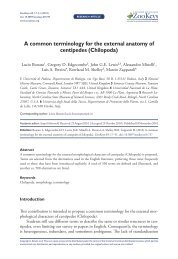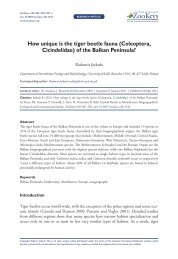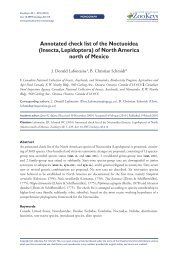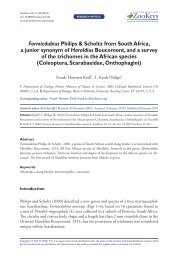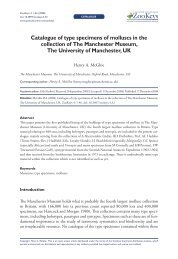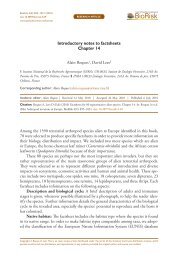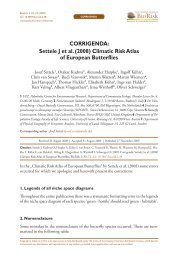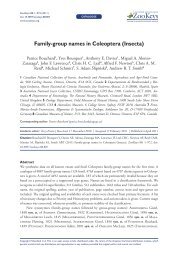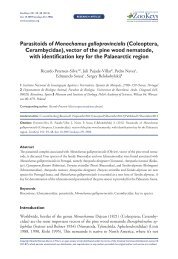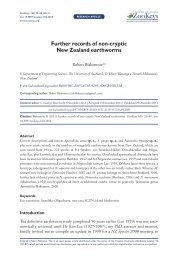Descriptions of Mature Larvae of the Bee Tribe - Pensoft Publishers
Descriptions of Mature Larvae of the Bee Tribe - Pensoft Publishers
Descriptions of Mature Larvae of the Bee Tribe - Pensoft Publishers
Create successful ePaper yourself
Turn your PDF publications into a flip-book with our unique Google optimized e-Paper software.
ZooKeys 148: 279–291 (2011)<br />
doi: 10.3897/zookeys.138.1839<br />
www.zookeys.org<br />
<strong>Descriptions</strong> <strong>of</strong> <strong>Mature</strong> <strong>Larvae</strong> <strong>of</strong> <strong>the</strong> <strong>Bee</strong> <strong>Tribe</strong> Emphorini and Its Subtribes... 279<br />
<strong>Descriptions</strong> <strong>of</strong> <strong>Mature</strong> <strong>Larvae</strong> <strong>of</strong> <strong>the</strong> <strong>Bee</strong> <strong>Tribe</strong><br />
Emphorini and Its Subtribes<br />
(Hymenoptera, Apidae, Apinae)<br />
Jerome G. Rozen, Jr.<br />
Division <strong>of</strong> Invertebrate Zoology, American Museum <strong>of</strong> Natural History, Central Park West at 79th St., New<br />
York, NY 10024, USA<br />
Corresponding author: Jerome G. Rozen, Jr. (rozen@amnh.org)<br />
Academic editor: Michael Engel | Received 22 July 2011 | Accepted 2 September 2011 | Published 21 November 2011<br />
Citation: Jerome G. Rozen, Jr. (2011) <strong>Descriptions</strong> <strong>of</strong> <strong>Mature</strong> <strong>Larvae</strong> <strong>of</strong> <strong>the</strong> <strong>Bee</strong> <strong>Tribe</strong> Emphorini and Its Subtribes<br />
(Hymenoptera, Apidae, Apinae). In: Engel MS (Ed) Contributions Celebrating Kumar Krishna. ZooKeys 148: 279–291.<br />
doi: 10.3897/zookeys.148.1839<br />
Abstract<br />
A description <strong>of</strong> <strong>the</strong> mature larvae <strong>of</strong> <strong>the</strong> bee tribe Emphorini based on representatives <strong>of</strong> six genera is<br />
presented herein. The two included subtribes, Ancyloscelidina and Emphorina, are also characterized and<br />
distinguished from one ano<strong>the</strong>r primarily by <strong>the</strong>ir mandibular anatomy. The anatomy <strong>of</strong> abdominal segments<br />
9 and 10 is investigated and appears to have distinctive features that distinguish <strong>the</strong> larvae <strong>of</strong> <strong>the</strong><br />
tribe from those <strong>of</strong> related apine tribes.<br />
Keywords<br />
Emphorini, Emphorina, Ancyloscelidina, larva, last larval instar<br />
Introduction<br />
RESEARCH ARTICLE<br />
A peer-reviewed open-access journal<br />
Launched to accelerate biodiversity research<br />
A recent study <strong>of</strong> <strong>the</strong> immature stages <strong>of</strong> <strong>the</strong> Exomalopsini (Rozen in press) presented<br />
a preliminary tribal key based on last larval instars to <strong>the</strong> non-cleptoparasitic apine<br />
taxa whose larvae were available, exclusive <strong>of</strong> <strong>the</strong> corbiculate tribes. It revealed that<br />
<strong>the</strong> last stage larva <strong>of</strong> Ancyloscelis apiformis (Fabricius) was in certain ways remarkably<br />
different from those <strong>of</strong> o<strong>the</strong>r Emphorini. To investigate <strong>the</strong>se differences <strong>the</strong> present<br />
paper describes <strong>the</strong> tribe based on its mature larvae and <strong>the</strong>n <strong>of</strong>fers a larval description<br />
<strong>of</strong> Ancyloscelis (based primarily on A. apiformis), <strong>the</strong> only genus in <strong>the</strong> subtribe<br />
Ancyloscelidina, and compares it with a characterization <strong>of</strong> mature larvae <strong>of</strong> <strong>the</strong> sub-<br />
Copyright Jerome G. Rozen, Jr.. This is an open access article distributed under <strong>the</strong> terms <strong>of</strong> <strong>the</strong> Creative Commons Attribution License, which<br />
permits unrestricted use, distribution, and reproduction in any medium, provided <strong>the</strong> original author and source are credited.
280<br />
Jerome G. Rozen, Jr. / ZooKeys 148: 279–291 (2011)<br />
tribe Emphorina as listed in Table 1. Although Roig-Alsina and Michener (1993) first<br />
proposed <strong>the</strong> subtribe Ancyloscelina for Ancyloscelis, <strong>the</strong> tribal name was corrected as<br />
Ancyloscelidina and validated by Engel and Michener in Engel (2005). These are <strong>the</strong><br />
only two subtribes <strong>of</strong> <strong>the</strong> Emphorini (Michener 2007).<br />
With great pleasure I dedicate this study to Drs. Kumar and Valerie Krishna, longterm<br />
associates and currently next-door <strong>of</strong>fice neighbors, whom I have known for nearly<br />
a half century. May <strong>the</strong>ir good humor and scholarship prevail long into <strong>the</strong> future!<br />
Aspects <strong>of</strong> <strong>the</strong> biology <strong>of</strong> Ancyloscelis apiformis were described by Torchio (1974),<br />
Michener (1974), and Rozen (1984), and more recently Gonzalez et al. (2007) treated<br />
<strong>the</strong> biology <strong>of</strong> Ancyloscelis aff. apiformis. Previous descriptions <strong>of</strong> immature stages were<br />
listed by McGinley (1989).<br />
In <strong>the</strong> study <strong>of</strong> larval Exomalopsini, <strong>the</strong> highly sclerotized mandibular morphology<br />
revealed considerable structural variation; this variation was not reflected in <strong>the</strong><br />
surrounding mouthparts, presumably because <strong>of</strong> <strong>the</strong>ir s<strong>of</strong>t, non-sclerotized anatomy.<br />
A preliminary survey <strong>of</strong> emphorine larval mandibles from <strong>the</strong> earlier study revealed<br />
mandibular variation as remarkable as that <strong>of</strong> <strong>the</strong> Exomalopsini, thus prompting <strong>the</strong><br />
current study.<br />
Methods and terminology<br />
For clearing, larvae were boiled in an aqueous solution <strong>of</strong> sodium hydroxide, stained<br />
with Chlorazol Black E, and <strong>the</strong>n submerged in glycerin on well slides for study and<br />
storage. Specimens to be examined with a Hitachi S-4700 scanning electron microscope<br />
(SEM) were critical-point dried and <strong>the</strong>n coated with gold/palladium. Microphotographs<br />
<strong>of</strong> Figs. 1–3 were taken with a Microptics-USA photographic system equipped<br />
with an Infinity Photo-Optic K-2 lens system. Microphotographs <strong>of</strong> mandibles were<br />
taken with a Cannon PowerShot SD880 IS handheld to <strong>the</strong> ocular <strong>of</strong> a Zeiss compound<br />
microscope. Fig. 12 was rendered with a Carl Zeiss LSM 710 confocal microscope.<br />
Table 1 gives <strong>the</strong> full name and authorship <strong>of</strong> all species treated herein.<br />
For descriptions <strong>of</strong> mandibles, <strong>the</strong> right mandible is used and assumed to have its<br />
long axis horizontal making <strong>the</strong> upper surface dorsal, lower surface ventral, and inner<br />
surface <strong>the</strong> adoral surface. As explained in Rozen (in press), <strong>the</strong> cusp is defined as an<br />
adoral extension <strong>of</strong> <strong>the</strong> apical mandibular edge that forms <strong>the</strong> upper boundary <strong>of</strong> <strong>the</strong><br />
apical concavity. It seems well represented in <strong>the</strong> Emphorina but greatly modified in<br />
Ancyloscelidina because <strong>of</strong> <strong>the</strong> blade-like thinness <strong>of</strong> <strong>the</strong> mandibular apex and <strong>the</strong><br />
coarse serrations <strong>of</strong> <strong>the</strong> dorsal apical edge (Figs. 12, 21, 22). The ventrally projecting<br />
tubercle-like structure and surrounding uneven surface (Figs. 12, 21) near <strong>the</strong> basal<br />
boundary <strong>of</strong> <strong>the</strong> apical concavity is likely a derived modification <strong>of</strong> <strong>the</strong> cusp.<br />
To determine <strong>the</strong> foramen-to-head-width index <strong>of</strong> mature larvae, <strong>the</strong> maximum<br />
transverse width <strong>of</strong> <strong>the</strong> foramen was divided by <strong>the</strong> maximum transverse head width.<br />
This is a measure <strong>of</strong> <strong>the</strong> degree <strong>of</strong> constriction <strong>of</strong> <strong>the</strong> posterior edge <strong>of</strong> <strong>the</strong> head capsule<br />
relative to <strong>the</strong> lateral expansion <strong>of</strong> <strong>the</strong> parietals.
<strong>Descriptions</strong> <strong>of</strong> <strong>Mature</strong> <strong>Larvae</strong> <strong>of</strong> <strong>the</strong> <strong>Bee</strong> <strong>Tribe</strong> Emphorini and Its Subtribes... 281<br />
Table 1. Taxa <strong>of</strong> <strong>the</strong> Emphorini whose mature larvae were examined for current study, with source <strong>of</strong><br />
material and o<strong>the</strong>r information<br />
EMPHORINI<br />
Ancyloscelidina:<br />
Ancyloscelis apiformis (Fabricius)<br />
Emphorina:<br />
Diadasia (Diadasia) enavata (Cresson)<br />
D. (Dasiapis) olivacea (Cresson)<br />
D. (Coquillettapis) rinconis Cockerell<br />
D. (Coquillettapis) vallicola Timberlake<br />
Diadasina (Diadasina) sp.<br />
Melitoma grisella (Cockerell & Porter)<br />
M. marginella (Cresson)<br />
M. segmentaria (Fabricius)<br />
Ptilothrix bombiformis (Cresson)<br />
P. near sumichrasti (Cresson)<br />
P. tricolor (Friese)<br />
Toromelissa nemaglossa (Toro & Ruz)<br />
Anatomy <strong>of</strong> Abdominal Apex<br />
KU and AMNH collections<br />
Michener, 1953; AMNH collection<br />
AMNH collection<br />
“<br />
“<br />
“<br />
“<br />
“<br />
“<br />
Michener, 1953; AMNH collection<br />
AMNH collection<br />
“<br />
“<br />
This section explores <strong>the</strong> anatomy <strong>of</strong> abdominal segments 9 and 10 <strong>of</strong> <strong>the</strong> emphorine<br />
last larval instar because certain features found <strong>the</strong>re have been overlooked. Although<br />
this study is based primarily on <strong>the</strong> predefecating larva <strong>of</strong> Melitoma grisella (Cockerell<br />
and Porter) and Diadasia rinconis Cockerell, <strong>the</strong>se features are evident on all emphorine<br />
larvae examined. Abdominal segments 9 and 10 each has a scarcely visible dorsal<br />
sclerotized area that is nearly unpigmented. However, when a specimen is cleared and<br />
stained with Chlorazol Black E, <strong>the</strong> sclerite <strong>of</strong> abdominal segment 9 is visible (although<br />
poorly delineated) as a narrow, transverse, somewhat impressed (compare with<br />
surrounding integument) dark band (Figs. 1, 2) tapering at both ends and stretching<br />
across <strong>the</strong> segment somewhat more than halfway to <strong>the</strong> segment’s posterior edge. Although<br />
its anterior margin in gently curved, its posterior margin is broadly V-shaped<br />
and points toward <strong>the</strong> following segment.<br />
The stained transverse sclerite (also not sharply delineated) <strong>of</strong> abdominal segment<br />
10 rings much <strong>of</strong> <strong>the</strong> segment but fades ventrally. Its anterior margin approaches<br />
<strong>the</strong> preceding segment at mid line, so that <strong>the</strong> sclerites <strong>of</strong> abdominal segments<br />
9 and 10 point toward one ano<strong>the</strong>r suggesting that <strong>the</strong>y function toge<strong>the</strong>r.<br />
The dorsal part <strong>of</strong> <strong>the</strong> posterior edge <strong>of</strong> <strong>the</strong> sclerite on segment 10 bends outward<br />
forming a shallow groove in front <strong>of</strong> it. The abdominal apex lies beyond this sclerite,<br />
and <strong>the</strong> anus (Figs. 1, 11, 16, 17) is a transverse slit, positioned a short distance posterior<br />
to <strong>the</strong> sclerite. The surface <strong>of</strong> <strong>the</strong> abdominal apex between anus and sclerite<br />
projects beyond <strong>the</strong> sclerite as <strong>the</strong> raised, verrucose supra-anal surface (Figs. 11, 16,<br />
17) with its dorsal edge forming a semicircle from one side <strong>of</strong> <strong>the</strong> anus to <strong>the</strong> o<strong>the</strong>r<br />
when viewed from behind (Figs. 11, 16, 17). This edge <strong>of</strong>ten becomes carinate on<br />
postdefecating specimens creating a ridge circling <strong>the</strong> anus from above (Figs. 11,
282<br />
Jerome G. Rozen, Jr. / ZooKeys 148: 279–291 (2011)<br />
Figures 1–3. Microphotographs <strong>of</strong> terminal abdominal segments <strong>of</strong> cleared, stained emphorine larvae. 1,<br />
2 Melitoma grisella, predefecating, dorsal and lateral views 3 Diadasia rinconis, postdefecating, lateral view.<br />
16). The area below <strong>the</strong> anus is planar, defined as a semicircle by <strong>the</strong> conspicuous<br />
setae at <strong>the</strong> border in <strong>the</strong> case <strong>of</strong> Melitoma grisella (Figs. 1, 2, 17); in o<strong>the</strong>r species<br />
that area is less well-defined. Hence, <strong>the</strong> dorsal view <strong>of</strong> <strong>the</strong> abdominal apex is an<br />
oval, traversed by <strong>the</strong> anus (Fig. 1).<br />
The dorsal sclerites <strong>of</strong> abdominal segments 9 and 10 and <strong>the</strong> position <strong>of</strong> <strong>the</strong> anus<br />
with projecting, verrucose surface, all ringed by fine setae, suggest that <strong>the</strong>se structures<br />
function toge<strong>the</strong>r for some purpose currently not understood. One can speculate that<br />
<strong>the</strong>se modifications support fecal deposition or perhaps deposition <strong>of</strong> some substance<br />
on <strong>the</strong> cell wall to safeguard <strong>the</strong> bee from water loss or parasites. Instead, <strong>the</strong>se features<br />
might relate in some way to locomotion, for how does such an elongate larva move<br />
around in <strong>the</strong> cell while it feeds and defecates? Careful observations <strong>of</strong> living specimens<br />
during this stadium will likely lead to an explanation.
<strong>Descriptions</strong> <strong>of</strong> <strong>Mature</strong> <strong>Larvae</strong> <strong>of</strong> <strong>the</strong> <strong>Bee</strong> <strong>Tribe</strong> Emphorini and Its Subtribes... 283<br />
<strong>Mature</strong> larva <strong>of</strong> Emphorini<br />
Diagnosis: The best way to distinguish larval emphorines from those <strong>of</strong> o<strong>the</strong>r apid tribes<br />
is with <strong>the</strong> characters indicated in <strong>the</strong> preliminary tribal key based on last larval instars<br />
to <strong>the</strong> non-cleptoparasitic apine taxa (Rozen, in press). The presence <strong>of</strong> fine to moderate<br />
setae on abdominal segment 10 is a feature restricted to <strong>the</strong> Emphorini and to <strong>the</strong> exomalopsine<br />
genus Eremapis among <strong>the</strong> Apidae, but Eremapis lacks <strong>the</strong> sclerites <strong>of</strong> abdominal<br />
segments 9 and 10. Unlike o<strong>the</strong>r emphorines, Toromelissa nemaglossa (Toro and Ruz),<br />
known from Chile, has only a pair <strong>of</strong> setae on <strong>the</strong> outer surface <strong>of</strong> its mandible, although<br />
like o<strong>the</strong>r emphorine taxa it does possess numerous scattered fine setiform sensilla on<br />
abdominal segment 10 as well as a spiculate mandibular corium. No o<strong>the</strong>r bee larva is<br />
known to possess this combination <strong>of</strong> characters. The following is based on mature larvae<br />
<strong>of</strong> species listed in Table 1, which also indicates <strong>the</strong> sources <strong>of</strong> preserved specimens.<br />
Head (Figs. 5, 8, 9, 13): Integument <strong>of</strong> head capsule with scattered, small sensilla,<br />
many <strong>of</strong> which are clearly setiform; epipharyngeal surface spiculate but with different<br />
patterns <strong>of</strong> distribution; mandibular corium nonspiculate, except clearly spiculate in<br />
Toromelissa and in some Diadasia. Integument pigmentation variable; mandible pigmented<br />
apically but far less so basally, with pigmented area usually defined by sharp<br />
line <strong>of</strong> separation (Figs. 24, 26, 28, 30, 32, 34); hypopharyngeal groove distinct.<br />
Head (Figs. 6, 7) moderately to very small relative to elongate body (Figs. 6, 7);<br />
width <strong>of</strong> foramen magnum compared to head width as follows: Ancyloscelis 0.73; Diadasia<br />
0.66–0.70; Diadasina 0.67; Melitoma 0.65–0.72; Ptilothrix 0.71; Toromelissa 0.71;<br />
bridge between posterior tentorial pits well developed; rest <strong>of</strong> tentorium normally robust<br />
for cocoon-spinning larva (even though not all spin cocoons). Center <strong>of</strong> anterior tentorial<br />
pit much closer to anterior mandibular articulation than to outer ring <strong>of</strong> antenna in<br />
frontal view (Figs. 9, 13; ATP = anterior tentorial pit), so that lateral segment (between<br />
anterior tentorial pit and anterior mandibular articulation) <strong>of</strong> epistomal ridge extremely<br />
short; posterior tentorial pit (i.e., junction point <strong>of</strong> postoccipital ridge, hypostomal<br />
ridge, and tentorial bridge) in normal position, deeply recessed; all internal head ridges<br />
strongly developed; coronal ridge extending to, or nearly to, middle <strong>of</strong> epistomal ridge<br />
in frontal view; median section <strong>of</strong> epistomal ridge more or less well developed; dorsomedial<br />
portion <strong>of</strong> postoccipital ridge nearly straight (not bending forward) as viewed from<br />
above; hypostomal ridge without distinct dorsal ramus. Parietal bands faintly evident<br />
as integumental scars. Antennal prominence non-extant; antennal papilla moderate to<br />
large in size, always longer than basal diameter, conical in shape, apically bearing 6 or<br />
more (in some cases many more) sensilla. Apex <strong>of</strong> labrum at most shallowly emarginated<br />
in frontal view (Figs. 9, 13); apical front surface <strong>of</strong> labrum with pair <strong>of</strong> low, forwardprojecting,<br />
sensilla-bearing lobes (Figs. 5, 8, 9, 13); transverse labral sclerite absent.<br />
Mandible with two apical teeth but on postdefecating forms mandible sometimes<br />
appearing to have single tooth because <strong>of</strong> wear; outer surface <strong>of</strong> mandible with 8 or<br />
more small to large setae at mid length, except Toromelissa with only a pair <strong>of</strong> setae; o<strong>the</strong>r<br />
mandibular features varying considerably between subtribes: see subtribal descriptions,
284<br />
Jerome G. Rozen, Jr. / ZooKeys 148: 279–291 (2011)<br />
below. Labiomaxillary region moderately weakly projecting in lateral view (Figs. 5, 8)<br />
for cocoon spinning larva. Maxilla with apex bent adorally, bearing palpus subapically;<br />
galea not evident; cardo and stipes sclerotized but in some cases unpigmented; articulating<br />
arm <strong>of</strong> stipital sclerite evident; maxillary palpus well developed, about twice as long<br />
as labial palpus but shorter and more slender than antennal papilla. Labium clearly divided<br />
into prementum and postmentum; prementum moderately small in frontal view;<br />
premental sclerite weakly evident; labial palpus about as long as basal diameter. Salivary<br />
opening on apex <strong>of</strong> prementum, transverse with strongly (Diadasina, Melitoma, Ptilothrix)<br />
to weakly (Ancyloscelis, Toromelissa) projecting lips that vary in width; lips consisting<br />
<strong>of</strong> tapering elongate filaments (Fig. 15). Except in Ancyloscelis, hypopharynx abruptly<br />
elevated behind articulating arms <strong>of</strong> stipes, high, sometimes densely covered with<br />
coarse spicules, o<strong>the</strong>r times with fewer, finer spicules; hypopharyngeal groove present.<br />
Body: Integument without general body setae, but abdominal segment 10 with fine<br />
to moderately conspicuous setae found especially around anus (a few setae may also be<br />
found dorsally on posterior part <strong>of</strong> segment 9); ventral surfaces <strong>of</strong> all segments with<br />
most species spiculate except for segment 10. Body form <strong>of</strong> predefecating larva (Fig.<br />
6) unusually elongate, linear, parallel-sided; extent <strong>of</strong> expression <strong>of</strong> inter- and intrasegmental<br />
lines variable on predefecating larva (partly determined by amount <strong>of</strong> food<br />
ingested), on postdefecating larva <strong>of</strong>ten evident; dorsal body tubercles usually absent<br />
but see Remarks, below; dorsal tubercles absent on abdominal segment 9; abdominal<br />
segment 9 on pre- and postdefecating forms produced ventrally as seen in lateral view<br />
(Figs 4, 6, 7); abdominal segment 10 positioned dorsally on 9 in lateral view (Figs. 4, 6,<br />
7); anus positioned close to dorsal surface on segment 10 (Figs. 2, 3); on postdefecating<br />
larvae, dorsal surface <strong>of</strong> segment 10 traversed by groove extending from one side<br />
<strong>of</strong> anus to o<strong>the</strong>r side, its posterior edge ending as strong transverse ridge above anus.<br />
Spiracles (Figs. 4, 6, 7) small to moderate sized, usually inconspicuous, subequal in size<br />
throughout, not surrounded by well defined sclerites, and not on tubercles; peritreme<br />
present; atrium projecting beyond body wall, with distinct rim, globose; atrial wall<br />
smooth, without ridges or spines, moderately thick; primary tracheal opening with<br />
collar; subatrium consisting <strong>of</strong> about 12 chambers; subatrial chambers decreasing in<br />
outside diameter from body surface inward. Males to extent known (but unknown in<br />
case <strong>of</strong> Ancyloscelis apiformis) with single median scar on apex <strong>of</strong> ventral protuberance<br />
<strong>of</strong> abdominal segment 9; females presumably lacking scars.<br />
Remarks: Although dorsal body tubercles are generally absent on mature larvae,<br />
earlier instars and even on early stages <strong>of</strong> last larval instars have paired tubercles on most<br />
body segments rising from <strong>the</strong> middle <strong>of</strong> each segment for abdominal segments 9 and<br />
10. (These tubercles should not to be confused with <strong>the</strong> middorsal tubercles <strong>of</strong> immature<br />
Megachilidae, which are intersegmental in position, Rozen and Hall (2011) figs. 85, 86.)<br />
Each tubercle is small but <strong>of</strong>ten rises sharply with its front-to-back measurement<br />
about <strong>the</strong> same as <strong>the</strong> lateral measurement (i.e., tubercle non-transverse). Tubercles<br />
are uniquely positioned for bee larvae: those <strong>of</strong> each segment tend to be contiguous,<br />
lying close to <strong>the</strong> body midline. On some species <strong>the</strong>y appear to be a single median<br />
bimodal tubercle.
<strong>Descriptions</strong> <strong>of</strong> <strong>Mature</strong> <strong>Larvae</strong> <strong>of</strong> <strong>the</strong> <strong>Bee</strong> <strong>Tribe</strong> Emphorini and Its Subtribes... 285<br />
Figures 4-8. 4–5. Diagrams <strong>of</strong> mature larva <strong>of</strong> Ancyloscelis apiformis, lateral view 4 Posterior part <strong>of</strong> abdomen<br />
<strong>of</strong> predefecating form 5 Head. 6–8. Diagrams <strong>of</strong> last larval instar <strong>of</strong> Diadasia rinconis, lateral view<br />
6 Predefecating form 7 Postdefecating form 8 Head, lateral view; Figs. 6 and 7 to same scale.<br />
Figures 9-12. 9–11. SEM micrographs <strong>of</strong> last larval instar <strong>of</strong> Ancyloscelis apiformis. 9 Head, frontal view<br />
10 Antenna with many sensilla 11 Abdominal segment 10, posterior view. 12. Confocal micrograph <strong>of</strong><br />
mandible <strong>of</strong> same, ventral view.
286<br />
Jerome G. Rozen, Jr. / ZooKeys 148: 279–291 (2011)<br />
<strong>Mature</strong> Larva <strong>of</strong> Subtribe Ancyloscelidina<br />
Description: Head (Figs. 5, 9): Epipharyngeal surface with patch <strong>of</strong> short but abundant<br />
spicules covering most <strong>of</strong> anterior surface on each side; mandibular corium nonspiculate.<br />
Integument unpigmented except for mandibular apices and mandibular points <strong>of</strong><br />
articulation with head capsule; hypopharyngeal groove faintly pigmented.<br />
Mandibular apex uniformly pale tan, with sharp line demarking tan apex from<br />
nearly pigmentless basal part <strong>of</strong> mandible as seen in dorsal view (Fig. 22, though value<br />
contrast generally not as great as in mandible <strong>of</strong> Emphorina). Entire mandibular<br />
apex rotated and flattened, blade-like, so that coarsely serrated dorsal edge directed<br />
adorally, forming very broad, ventrally directed apical concavity (Fig. 12); dorsal apical<br />
tooth elongate, gradually narrowing to acute point directed adorally (mandible<br />
appearing rapacious) (Figs. 12, 22); ventral apical tooth greatly reduced, scarcely<br />
noticeable (Figs. 12, 21, 22); ventral edge <strong>of</strong> apical concavity sharply defined by fine<br />
ridge, which toward base bears short series <strong>of</strong> small tubercles (Fig. 12, 21); dorsal<br />
apical edge <strong>of</strong> concavity broadening slightly toward base and bearing large, ventrally<br />
projecting tubercle and uneven surface at its base (Fig. 12); <strong>the</strong>se elements presumably<br />
homologue <strong>of</strong> mandibular cusp. Cardo and stipes sclerotized but unpigmented.<br />
Prementum moderately small in frontal view. Salivary lips weakly projecting, only<br />
about one-half as wide as distance between bases <strong>of</strong> labial palpi. Hypopharynx well<br />
behind apices <strong>of</strong> articulating arms <strong>of</strong> stipes, low, questionably bilobed, faintly spiculate<br />
on both sides.<br />
Material examined: 3 postdefecating larva: Trinidad: Maracas Valley, II-24-1966,<br />
III-01-1966 (F.D. Bennett, J.G. Rozen); 1 predefecating larva: same except III-08-<br />
1968 (J.G. and B.L. Rozen); 4 predefecating, 1 postdefecating larvae: Colombia: Valle<br />
del Cauca: Cali I-10-1972 (C.D. Michener).<br />
<strong>Mature</strong> Larva <strong>of</strong> Subtribe Emphorina<br />
Description: Head (Figs. 8, 13): Apicolateral angles <strong>of</strong> epipharyngeal surface angles<br />
with restricted swollen protuberances well separated from one ano<strong>the</strong>r, each <strong>of</strong><br />
which is densely covered with short spicules; mandibular corium nonspiculate, except<br />
clearly spiculate in Toromelissa nemaglossa and in some Diadasia. Integumental sclerotized<br />
areas, especially internal head ridges and sclerotized mouthparts, tending to be<br />
more pigmented than those <strong>of</strong> Ancyloscelidina.<br />
Apical part <strong>of</strong> mandible (including mandibular apex and all <strong>of</strong> cuspal area)<br />
very darkly pigmented, almost black; line separating pigmented and nonpigmented<br />
parts sharply defined as seen in dorsal (Figs. 24, 26, 28, 30, 32, 34) or ventral view.<br />
Mandibular apex usually with two apical teeth; dorsal tooth larger, ventral tooth<br />
slightly smaller (except approximately equal in Diadasina, Fig. 27, and in some<br />
species such as Diadasia olivacea, Fig. 25, ventral tooth longer than dorsal one);
<strong>Descriptions</strong> <strong>of</strong> <strong>Mature</strong> <strong>Larvae</strong> <strong>of</strong> <strong>the</strong> <strong>Bee</strong> <strong>Tribe</strong> Emphorini and Its Subtribes... 287<br />
Figures 13–16. SEM micrographs <strong>of</strong> postdefecating larva <strong>of</strong> Diadasia rinconis. 13 Head, frontal view<br />
14 Left mandible, showing setae on outer surface 15 Salivary lips, from above 16 Upper part <strong>of</strong> segment<br />
10, posterior view.<br />
dorsal apical mandibular edge without teeth; ventral mandibular tooth and ventral<br />
edge <strong>of</strong> mandibular apex twisted adorally forming elongate oblique apical concavity<br />
(Fig. 20) on adoral apical surface in conjunction with strongly produced dorsal<br />
apical edge (Fig. 20); when viewed dorsally (Figs. 19, 34) ventral tooth appearing<br />
more curved than dorsal tooth; adoral surface <strong>of</strong> cusp thick toward mandibular<br />
base; leading cuspal edge linear, rounded (Ptilothrix), or narrowly planar (Melitoma,<br />
Diadasia), without distinct spines, sometimes irregularly roughened or minutely<br />
pebbled (e.g., Diadasia enavata, Fig. 24). Prementum moderately small to moderately<br />
wide in frontal view. Salivary lips weakly to strongly projecting; width onehalf<br />
as wide, to as wide, as distance between bases <strong>of</strong> labial palpi. Hypopharynx well<br />
behind apices <strong>of</strong> articulating arms <strong>of</strong> stipes, <strong>of</strong>ten dorsally projecting, in some cases<br />
bilobed, spiculate on dorsal surface.<br />
Material examined: Diadasia enavata: 10+ larvae, all stages: USA: Washintdon:<br />
Yakima Co.: S <strong>of</strong> Granger, IX-5-1993 (E. Miliczky). D. olivacea: 3 predefecating last<br />
larval instars: USA: Arizona: Cochise Co.: Southwestern Research Station, 5 mi S <strong>of</strong><br />
Portal, IX-7-1773 (J.G. Rozen, M. Favreau). D. rinconis: 10+ larvae, all stages: USA:<br />
Arizona: Pima Co.: Arizona-Sonora Desert Museum, V-9-1987 (J.G. Rozen, S.L Buchmann);<br />
10+ mature larvae: same except: Catalina State Park, V.-8-1990 (S.L. Bu-
288<br />
Jerome G. Rozen, Jr. / ZooKeys 148: 279–291 (2011)<br />
Figure 17–20. SEM micrographs <strong>of</strong> mature larva <strong>of</strong> Melitoma grisella. 17 Left side <strong>of</strong> abdominal segment<br />
10, posterior view 18 Antenna 19 Mandible, dorsal view, and 20 inner view.<br />
chmann). D. vallicola: 10+ late stage larvae: USA: California: Riverside Co.: 18 mi<br />
W <strong>of</strong> By<strong>the</strong>, V-2-1991 (J.G. Rozen). Diadasina sp. 2 postdefecating larvae: Argentina:<br />
Chaco Prov.: Capitan Solari, I-31-2006 (J. Straka). Melitoma grisella: 10+ various<br />
larval instars: USA: Nebraska: Keith Co.: Cedar Point Biological Station, VII-20-<br />
1988 (J.G. Rozen). M. marginella: 1 postdefecating larva: Mexico: Jalisco: Chemela,<br />
XI-7-1986 (J.G. Rozen). M. segmentaria: 5 mature larvae: Trinidad: Nariva Swamp,<br />
X-12-1965 (F.D. Bennett). Ptilothrix bombiformis: 2 cast larval skins: USA: Maryland:<br />
Prince George Co.: Greenbelt, IX-21, 22-1986 (B. Norden). P. near sumichrasti: 3<br />
mature lavae: USA: Arizona: Cochise Co.: 8 mi NE <strong>of</strong> Portal, VIII-18–24- 990 (J.G.<br />
Rozen, J. Krieger). P. tricolor: 2 postdefecating larvae: Argentina: Tucumán Prov.: 11<br />
km NW <strong>of</strong> Cadillal, XII-4-1993 (J.G. Rozen). Toromelissa nemaglossa: 10+ larvae <strong>of</strong><br />
all stages: Chile: Atacama Region(III): Huasco Prov. 37 km W <strong>of</strong> Domeyko, XI11-11-<br />
2000 (J.G. Rozen).<br />
Remarks: In Diadasia enavata (and perhaps in some o<strong>the</strong>r species in that genus) <strong>the</strong><br />
ventral apical mandibular tooth appears missing (Michener, 1953: Figs. 209, 210). Examination<br />
<strong>of</strong> an early stage last larval instar (Fig. 23) shows that it clearly present, but<br />
in postdefecating forms it is worn away leaving <strong>the</strong> mandible with a broad, obliquely<br />
truncate apex, bearing a large, adorally directed apical concavity.
<strong>Descriptions</strong> <strong>of</strong> <strong>Mature</strong> <strong>Larvae</strong> <strong>of</strong> <strong>the</strong> <strong>Bee</strong> <strong>Tribe</strong> Emphorini and Its Subtribes... 289<br />
Figures 21–34. Right mandibles <strong>of</strong> mature larvae <strong>of</strong> Emphorini, showing inner view and dorsal view <strong>of</strong><br />
each representative, as labeled.
290<br />
Conclusions and discussion<br />
Jerome G. Rozen, Jr. / ZooKeys 148: 279–291 (2011)<br />
Because all taxa whose immatures were examined in this study possessed most if not<br />
all features <strong>of</strong> abdominal segments 9 and 10 described above, this character complex<br />
strongly supports <strong>the</strong> relationship <strong>of</strong> Ancyloscelis with <strong>the</strong> Emphorina, despite <strong>the</strong> very<br />
different mandibles <strong>of</strong> <strong>the</strong> two groups.<br />
Except for mandibular morphology, <strong>the</strong>re is a strong similarity among not only<br />
larval Ancyloscelidina, as represented by Ancyloscelis apiformis, and larvae <strong>of</strong> Emphorina,<br />
but also larvae <strong>of</strong> Exomalopsini (Rozen, in press) and Tetrapediini (Rozen, et<br />
al., 2006). These similarities include: body shape (protruding venter on abdominal<br />
segment 9, dorsally positioned anus, and paired low or virtually absent dorsal body<br />
tubercles); spiracle morphology; and head features (excluding mandible morphology).<br />
Acknowledgments<br />
I thank <strong>the</strong> following persons for donation <strong>of</strong> specimens <strong>of</strong> taxa (in paren<strong>the</strong>ses) used<br />
here to <strong>the</strong> American Museum <strong>of</strong> Natural History (AMNH): Jakub Straka (Diadasina<br />
sp.), Eugene Miliczky (Diadasia enavata), Fred Bennett (Melitoma segmentaria), and<br />
Beth Norden (Ptilothrix bombiformis). These donations added greatly to this investigation.<br />
I also thank Charles D. Michener for <strong>the</strong> loan <strong>of</strong> larval Ancyloscelis apiformis.<br />
Hea<strong>the</strong>r M. Campbell, Curatorial Assistant, AMNH, prepared specimens for<br />
SEM examination and took SEM micrographs in <strong>the</strong> Microscopy and Imaging Facility,<br />
AMNH. All illustrative material was arranged and labeled by Steve Thurston,<br />
Senior Scientific Assistant, AMNH. Both Hea<strong>the</strong>r M. Campbell and John S. Ascher,<br />
<strong>Bee</strong> Databasing Manager, AMNH, kindly reviewed <strong>the</strong> manuscript. I also extend my<br />
appreciation to <strong>the</strong> three anonymous reviewers for <strong>the</strong>ir corrections and helpful comments.<br />
References<br />
Engel MS (2005) Family-group names for bees (Hymenoptera: Apoidea). American<br />
Museum <strong>of</strong> Novitates 3476: 1–33. http://hdl.handle.net/2246/2786 doi:<br />
10.1206/0003-0082(2005)476[0001:FNFBHA]2.0.CO;2<br />
Gonzalez VH, Ospina M, Palacios E, Trujillo E (2007) Nesting habits and rates <strong>of</strong> parasitism<br />
in some bee species <strong>of</strong> <strong>the</strong> genera Ancyloscelis, Centris, and Euglossa (Hymenoptera: Apidae)<br />
from Colombia. Boletín del Museo de Entomología de la Universidad del Valle 8: 23–29.<br />
http://entomologia.univalle.edu.co/boletin/4Gonzalez-etal.pdf<br />
McGinley RJ (1989) A catalog and review <strong>of</strong> immature Apoidea (Hymenoptera). Smithsonian<br />
Contributions to Zoology 494: 1–24. http://www.sil.si.edu/smithsoniancontributions/Zoology/pdf_hi/SCTZ-0494.pdf<br />
doi: 10.5479/si.00810282.494
<strong>Descriptions</strong> <strong>of</strong> <strong>Mature</strong> <strong>Larvae</strong> <strong>of</strong> <strong>the</strong> <strong>Bee</strong> <strong>Tribe</strong> Emphorini and Its Subtribes... 291<br />
Michener CD (1953) Comparative morphology and systematic studies <strong>of</strong> bee larvae with a<br />
key to <strong>the</strong> families <strong>of</strong> hymenopterous larvae. The University <strong>of</strong> Kansas Science Bulletin 35:<br />
987–1102.<br />
Michener CD (1974) Fur<strong>the</strong>r notes on nests <strong>of</strong> Ancyloscelis (Hymenoptera: Anthophoridae).<br />
Journal <strong>of</strong> <strong>the</strong> Kansas Entomological Society 41: 19–22.<br />
Michener CD (2007) <strong>Bee</strong>s <strong>of</strong> <strong>the</strong> World, Second Edition. Johns Hopkins University Press,<br />
Baltimore, MD, 953 pp.<br />
Roig-Alsina A (1993) Studies <strong>of</strong> <strong>the</strong> phylogeny and classification <strong>of</strong> long-tongued bees (Hymenoptera:<br />
Apoidea). The University <strong>of</strong> Kansas Science Bulletin 55:124–173.<br />
Rozen JG Jr (1984) Comparative nesting biology <strong>of</strong> <strong>the</strong> bee tribe Exomalopsini (Apoidea: Anthophoridae).<br />
American Museum Novitates 2798: 1–37. http://hdl.handle.net/2246/5269<br />
Rozen JG Jr (in press) Immatures <strong>of</strong> exomalopsine bees with notes on nesting biology and a<br />
tribal key to mature larvae <strong>of</strong> non-corbiculate, non-parasitic Apinae (Hymenoptera: Apidae).<br />
American Museum Novitates.<br />
Rozen JG Jr, Hall HG (2011) Nesting and developmental biology <strong>of</strong> <strong>the</strong> cleptoparasitic bee<br />
Stelis ater (Anthidiini) and its host, Osmia chalybea (Osmiini) (Hymenoptera: Megachilidae).<br />
American Museum Novitates 3707: 1–38. http://hdl.handle.net/2246/6101 doi:<br />
10.1206/3707.2<br />
Rozen JG Jr, Melo GAR, Aguiar AJC, Alves-dos-Santos I (2006) Nesting biologies and immature<br />
stages <strong>of</strong> <strong>the</strong> tapinotaspidine bee genera Monoeca and Lanthanomelissa and <strong>of</strong><br />
<strong>the</strong>ir osirine cleptoparasites Protosiris and Parepeolus (Hymenoptera: Apidae). Appendix:<br />
Taxonomic notes on Monoeca and description <strong>of</strong> a new species <strong>of</strong> Protosiris, by Melo<br />
GAR. American Museum Novitates 3501: 1–60. http://hdl.handle.net/2246/3501 doi:<br />
10.1206/0003-0082(2006)501[0001:NBAISO]2.0.CO;2<br />
Torchio PF (1974) Notes on <strong>the</strong> biology <strong>the</strong> biology <strong>of</strong> Ancyloscelis armata Smith and comparisons<br />
with o<strong>the</strong>r anthophorine bees (Hymenoptera: Anthophoridae). Journal <strong>of</strong> <strong>the</strong> Kansas<br />
Entomological Society 47: 54–63.



